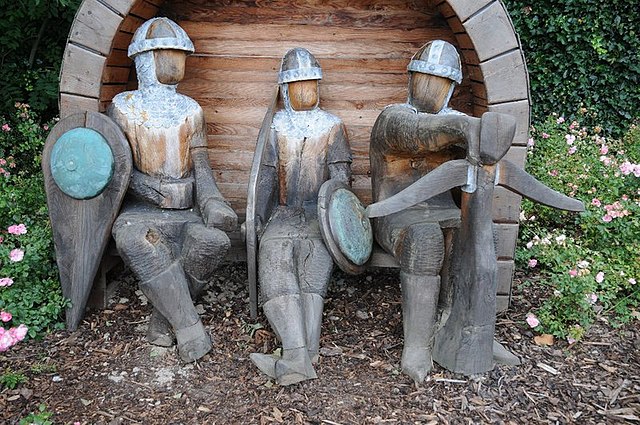‘Macbeth shall never vanquished be until Great Birnam Wood to high Dunsinane Hill shall come against him.’ This is the famous prophecy, which is foretold to Macbeth in Act 4, Scene 1 of the famous Shakespearean play. It was a warning that would later come into fruition when Macduff, Malcolm and the armies who opposed Macbeth stood on the outskirts of his fortress, disguised in foliage to make it appear as if Birnam Wood was moving. It was also a scene that would inspire J.R.R. Tolkien in the Lord of the Rings, especially in the chapter of ‘Flotsam and Jetsam,’ and in the fall of Isengard, in which the woods really did move on the fortress of Orthanc.
What I want to ponder today is could have Birnam Woods properly moved on Macbeth? Of course, Ents (sadly) do not really exist and trees in general cannot walk, but could we take the armies of Malcolm and Macduff’s approach to blending in with the woods one step further? Could those armies become the woods? Could any army properly furnish themselves with armaments made only from wood? The idea of a ‘wooden army’ sounds like something from a Narnia novel, but could it actually work in practice and be successful in combat?
I will break my question down into four parts. Could wooden weapons be made? Could wooden armour be made? Could other pieces of equipment be made from wood? And who could be defeated by a wooden army?
Starting off with weapons, we can see a plethora of arms that a simple tree could make. Firstly, we can look at wooden weapons based on traditional metal swords. Wasters, the Bokken and the Shinai are all wooden swords of sorts (the latter two originating from Japan, whilst Wasters come from Europe). They are often used for martial arts, training or as ornamental pieces – but that’s not to say they can’t be lethal. The 16th going on 17th century swordsman and philosopher, Miyamoto Musashi, was said to only wield the Bokken in combat, and would be successful in taking down opponents. So, with skilled usage, weapons like the Bokken could kill, but for a whole army not everyone may be able to achieve such skill with these weapons. For an army scenario, something that can be easily used in combat effectively would be desirable. For this we can turn to Polynesian culture, with several wooden war weapons. An example we can look at here can be in the Totokia, a war club originating from Fiji designed to mimic a birds beak, and be lethal when struck by it – with it famously being the basis for the Gaffi Sticks of the Tusken Raiders from Star Wars. The Polynesian weapons are of great use for an all wooden army, but what if we want to not just rely on close combat weaponry? The first thought that may come to mind is the simple bow and arrow, however the fibres in a bow do not necessarily come from a tree, so we cannot use the bow in this case. The next simple alternative that we are allowed to use is the spear – a simple yet effective weapon for dealing with enemies (though not as far reaching as the bow would have been). Another throwing weapon that can be used here would be the boomerang, another wooden weapon that would be effective in harming an enemy, as was first seen by European settlers in Port Jackson, Sydney in 1804. So now we have gone over all the weapons that would be useful to attack a person made entirely from wood, but how would our theoretical army defend themselves using only wooden objects?
Firstly we should consider one of the sturdiest wooden defences for any form of soldier, the shield. Shields, for the most part, are just large masses of wood that a soldier would hold to block attacks. Whilst often reinforced with metal of some kind, the shield can just be simple wooden in design and still be effective in protecting soldiers. Whilst the wooden shield was common, wooden armour was not. The Haida (a group native to parts of British Columbia) were famous in wearing rod-and-slat armour, consisting of long wooden slats and greaves covering their torso. Similarly, the Tlingit group would also wear a large wooden armour piece in combat – yet both groups would layer their wooden armour with either animal hide (for the Haida) or makeshift chain mail made from imported Chinese coins (for the Tlingit). So outright protection akin to medieval European armour would be near impossible, but this wouldn’t stop a group of guerrilla-esque warriors from wearing the armour, alongside perhaps camouflaging themselves with leaves from the trees for camouflage. If we are talking about defence as well, we could also stretch the usage of wooden material to traps like the Vietnamese Punji Sticks (made from simple Bamboo, which is a wood type of sorts). So, can an armour successfully protect themselves with armour made only from wood? Potentially yes. In a guerrilla scenario with quick movement and surprise attacks, like in Vietnam, any group using wooden armour (and wooden weaponry) would be able to successful take down opponents in the right conditions. So we have furnished our army with the essentials for combat, but what about other gear? Can this too be made of wood?
Trees can provide the materials for basic gear that would be useful for any soldier. Bark of dead trees can be turned into natural cordage, a rope of sorts, that may be useful in repairing weaponry, armour or perhaps binding a prisoner’s hands. Sadly, any medium of carrying water would be harder to make. Whilst it is probably possible to make a water bottle out of wood, there are few if no historical records about groups who would make canteen style water vessels out of wood (as most were made from leather or animal hide), and the closest we can get to any water vessel in a historical sense is just a wooden bucket to carry water – so our theoretical army would often have to be close to some form of water supply, or just constantly keep several buckets worth of water at hand. If we want to look at garments for our army other than actual armour, we can look at the material rayon, used in making clothes, derived from wood pulp. Admittedly, rayon is formed via mechanical and chemical processes – so for our tree hugging soldiers it probably would be hard to make. Yet the material still exists, so I am going to class it here as a possibility to be made and used. If we are simply using the definition of tree again, we can also look to bamboo t-shirts as an example of clothing made of wood, and apply clothing made from bamboo to general garments. And finally, if we want our soldiers to be able to start a fire, we can use extremely dry sticks and other twigs and logs to start a fire, via the old but reliable technique of rubbing a dry stick on a larger piece of wood until it starts to smoke. So now we have gone through all that our wooden army would need for combat and general management, who would we say this army would be capable of defeating?
It is fair to say that the majority of battles this wooden army would have general success in would be against local primitive tribes, from Polynesian tribes to Gaelic tribes. If they were to be punching above their weight, our theoretical army may defeat the likes of the Romans, similar to Roman defeats such as the Battle of the Allia or the defeats suffered at the hand of Boudica. Sadly, it would be unlikely that this army could successfully march on any force like that of Macbeth’s, as by the real time of Macbeth (the 11th century), most soldiers used some form of metal protection which would outrank our wooden armour. But, based on the previous views of Guerrilla tactics, it could be very possible that well trained members of our army could take down early modern soldiers in simple fabrics like Khaki, with there being the potential to perhaps take down American soldiers in Vietnam, similar to the successful nature of the Vietcong – alongside Victorian British forces akin to those who were sent out to New Zealand and also faced significant resistance between 1845 and 1872.
So is a army entirely made up of conscripts using material only fashioned from wood possible? Yes. Is it very successful? No. Whilst in combat, weapons like the Totokia or the spear may prove effective over primitive tribes and (perhaps) against Roman forces, the material of wood would not be durable enough for all out combat – and would be prone to rotting, and easily broken by metal weapons. But it is still a fun thought experiment, and its potential success is probably larger than one might expect. Sadly, no wooden army every assembled on a mass scale, and we probably will never see one in active combat ever. But it is still interesting to think what would have happened if Birnam Wood did really move, or what a more realistic march of the Ents might look like, and we can still imagine what might have happened if a wooden army did ever rise.

